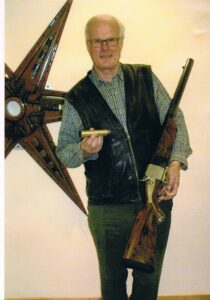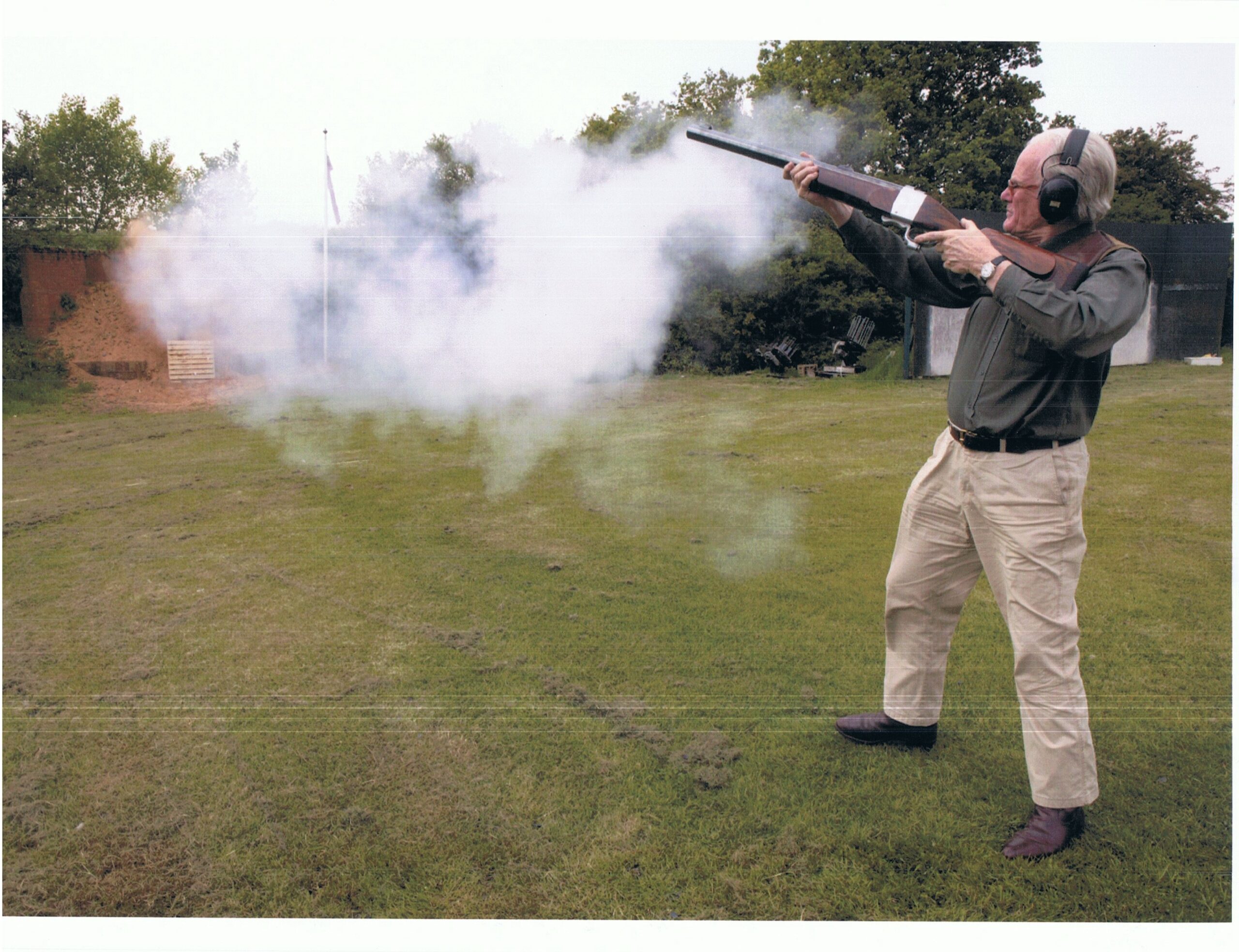
By Jim Dickson | Contributing Writer
Sixty years ago Tanganyika was unrecognizable to today’s folk.
The Southern province there had a population of 10,000 elephants which would increase by 20 percent each year if not harvested. This increase was always at the expense of the native farmers as the elephants ate the crops and were perfectly willing and able to kill any native that dared to object and get in their way. This was unacceptable to the colonial officers.
The Tanganyika Elephant Control Office of Southern Province Tanganyika consisted of three officers whose job it was to keep the population at 10,000. Giles Whittome was a young ivory hunter in those days and he was friends with all three of them. They were quick to send him out wherever they needed elephants culled.
Giles was a strapping 6 foot 5 youth who had spent 50 pounds buying a .500 Nitro Express non-ejector hammerless boxlock made by the famous London maker John Wilkes. The rare 3 ¼-inch chambering gave the same velocity as the common 3-inch chambering but at lower pressures. That was important with cordite propellant at tropical temperatures. This gun had previously belonged to three senior game wardens and had accounted for more than 1,100 elephants. Throat erosion from the hot burning cordite ammunition had destroyed the rifling for the first 9 or 10 inches in front of the chambers but it still would put the shots from both barrels in a two-inch group at 50 yards if the correct .500-caliber, 3 ¼-inch ammunition was used instead of the more common 3-inch cartridges. Giles let that gun get away from him when he left Africa and would like to buy it back if it can be located. The serial number was 5387.
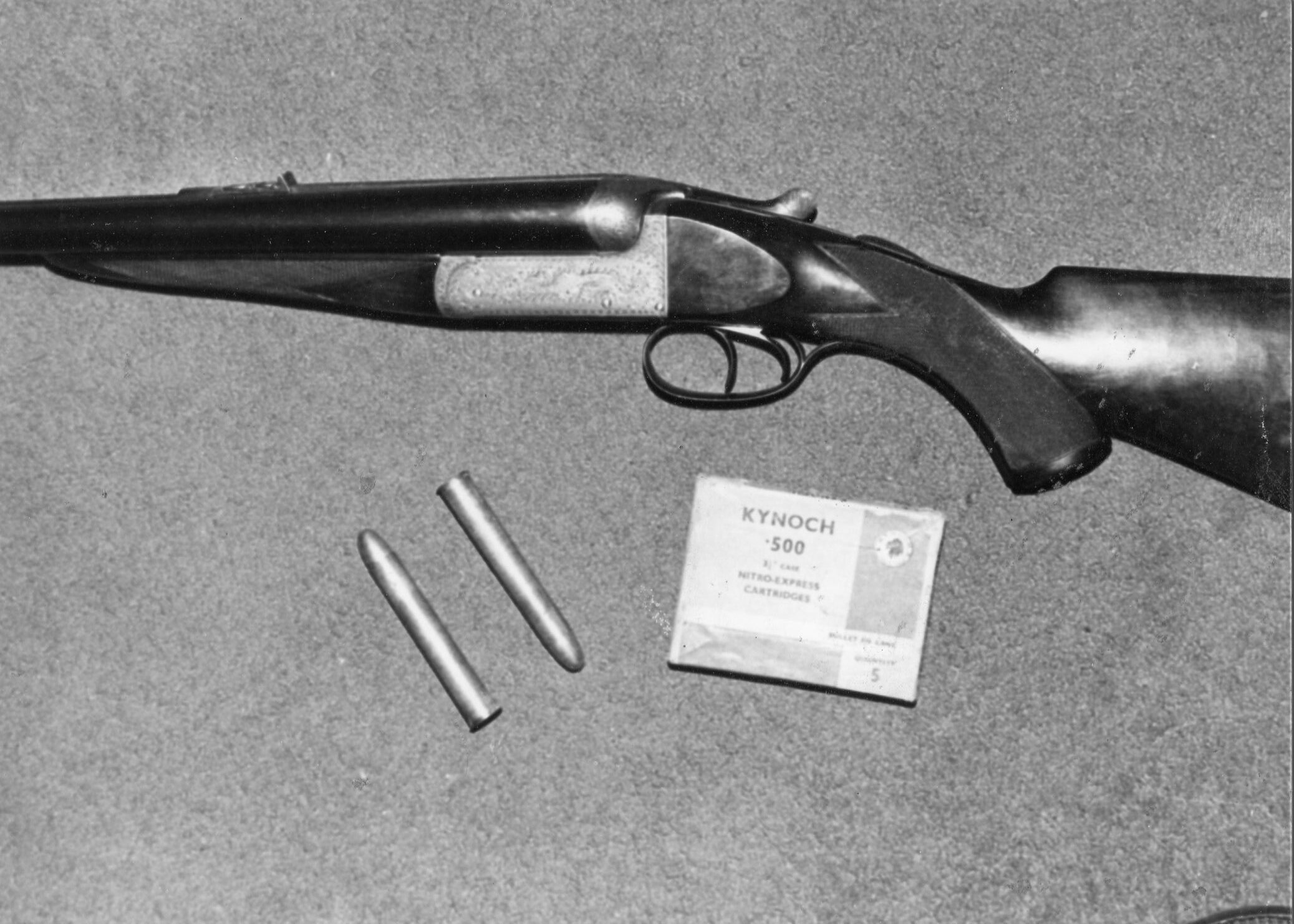
This gun weighed 14 pounds which was about the perfect weight for it. Not too heavy to carry all day in the infernal tropical heat which could reach 120 degrees Fahrenheit yet having enough weight that it did not kick too hard.
It did not have ejectors as these make a ping when they throw out the empties that can point out your location to a herd of milling elephants that are looking for you with murder on their minds. Experienced elephant hunters generally wanted a double instead of a bolt action because the fast second shot could mean the difference between life and death for them. Remember, there was no one backing them up with a second gun like you see on today’s paid safaris. The lifesaving effect of that instantly available second shot was well proven in the following encounter.
Like all the professional ivory hunters Giles hunted alone with no back-up, just a few natives to carry back what he had shot. This was nothing like the guided hunts of today where the hunter has a back-up and the guide steers him clear of dangerously thick cover so he can hunt elephants in relative safety. In those far off days if you wanted the white gold of ivory you took any risk in stride.
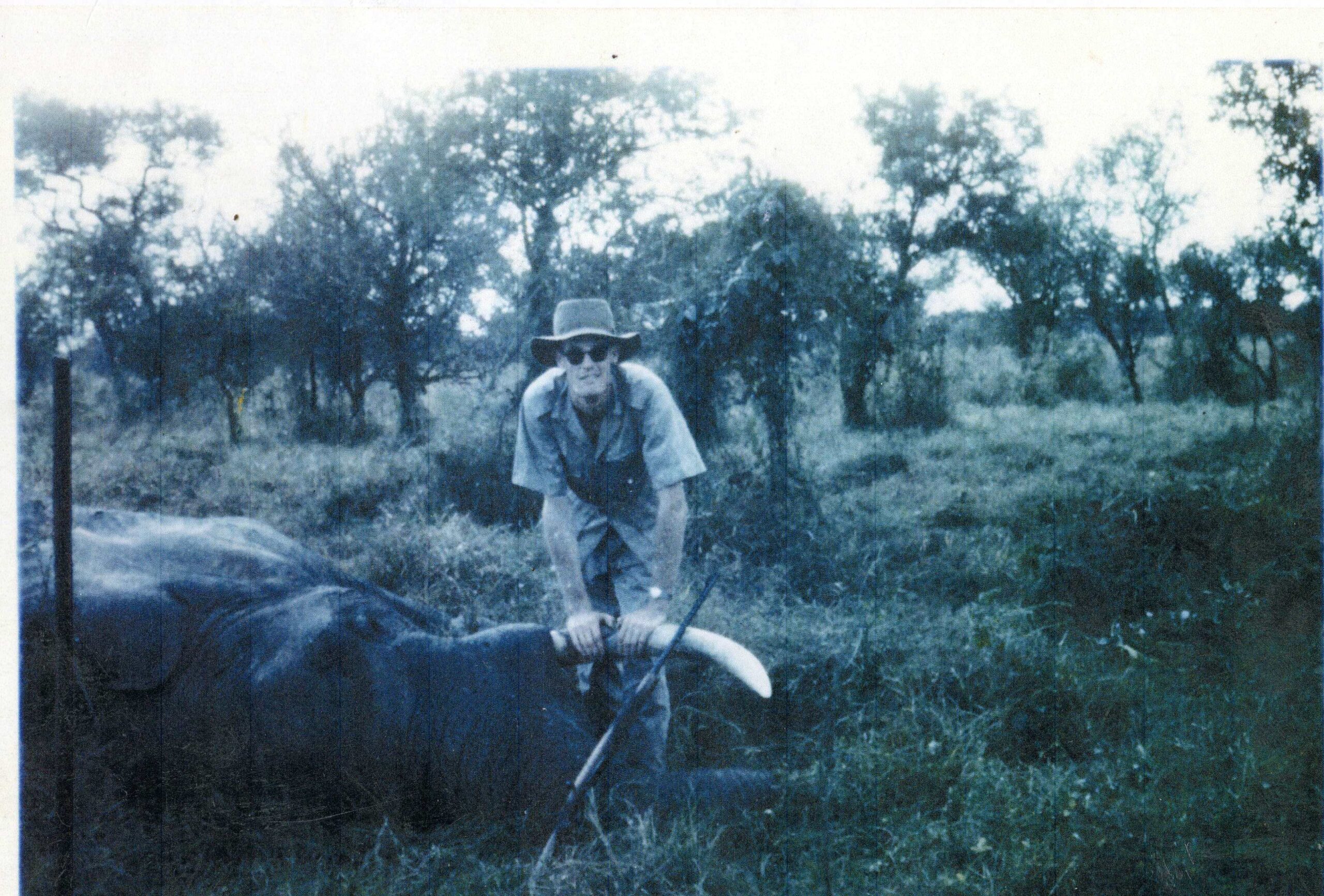
Giles was ivory hunting in South Tanganyika near Mikindani village under the most dangerous conditions of all. When hunting in thick brush with the wind blowing strongly away from the elephant toward you the elephant cannot smell, hear, or see your approach and you cannot see him either. This is when the professional ivory hunter’s worst nightmare occurs. Finding out the tree trunks on each side of you are the elephant’s forelegs. This not uncommon event is what the old ivory hunters refer to as a “brown pants day.”
Giles was carefully stalking his elephant in brush so thick he could not see through it when the trees on either side of him turned out to be covered in elephant hide. Looking up at the elephant that was just now beginning to be aware of him there Giles took the only shot he could. Straight up through the underside of the elephant’s jaw hoping to hit the brain. The old ivory hunters will tell you that hitting the brain from this angle is almost impossible but a near miss from a big caliber like a .500 can knock him out long enough for a second shot when a smaller caliber may not. The elephant’s skull is spongy fluid filled bone and a big .500 slug has enough hydrostatic shock there to hit the brain like Jack Dempsey’s boxing glove knocking his opponent out cold.
The elephant came crashing down at the shot like he was poleaxed and Giles was barely able to jump out of the way to keep from being smashed like a bug. Instantly he spun around and fired that fast second shot into the brain of the downed elephant before he could shake off the effects of the first shot and attack. Some people who were never professional ivory hunters will say that you should not hunt in such thick cover but the old ivory hunters did what they had to do to make a living. Pushing through the thick stuff was a part of hunting in these places and you just hoped the elephants were on the other side of it instead of in the middle of it.
Giles had another of these extremely close encounters in thick brush. The wind was blowing strong and preventing the elephant smelling or hearing Giles while the brush hid both parties from each other. Giles could smell the elephant he was stalking but not being a bird dog he could not locate him with his nose. Suddenly the elephant’s tusks loomed overhead. Both the elephant and Giles saw each other at the same instance. The big Wilkes .500 bullet went through the elephant’s trunk but did no other damage. Having effectively been punched in the nose by the massive 570-grain slug the elephant took off. Night came and Giles and his trackers spent the night out camped on the trail. The next day they caught up with the elephant which promptly charged. A frontal brain shot dropped him and Giles was extremely pleased to hear his tracker yell ameanguka! Which means he has fallen. Giles was down to his last bullet for some reason he can’t remember why after all this time. Usually he had a surplus of shells but not this time.
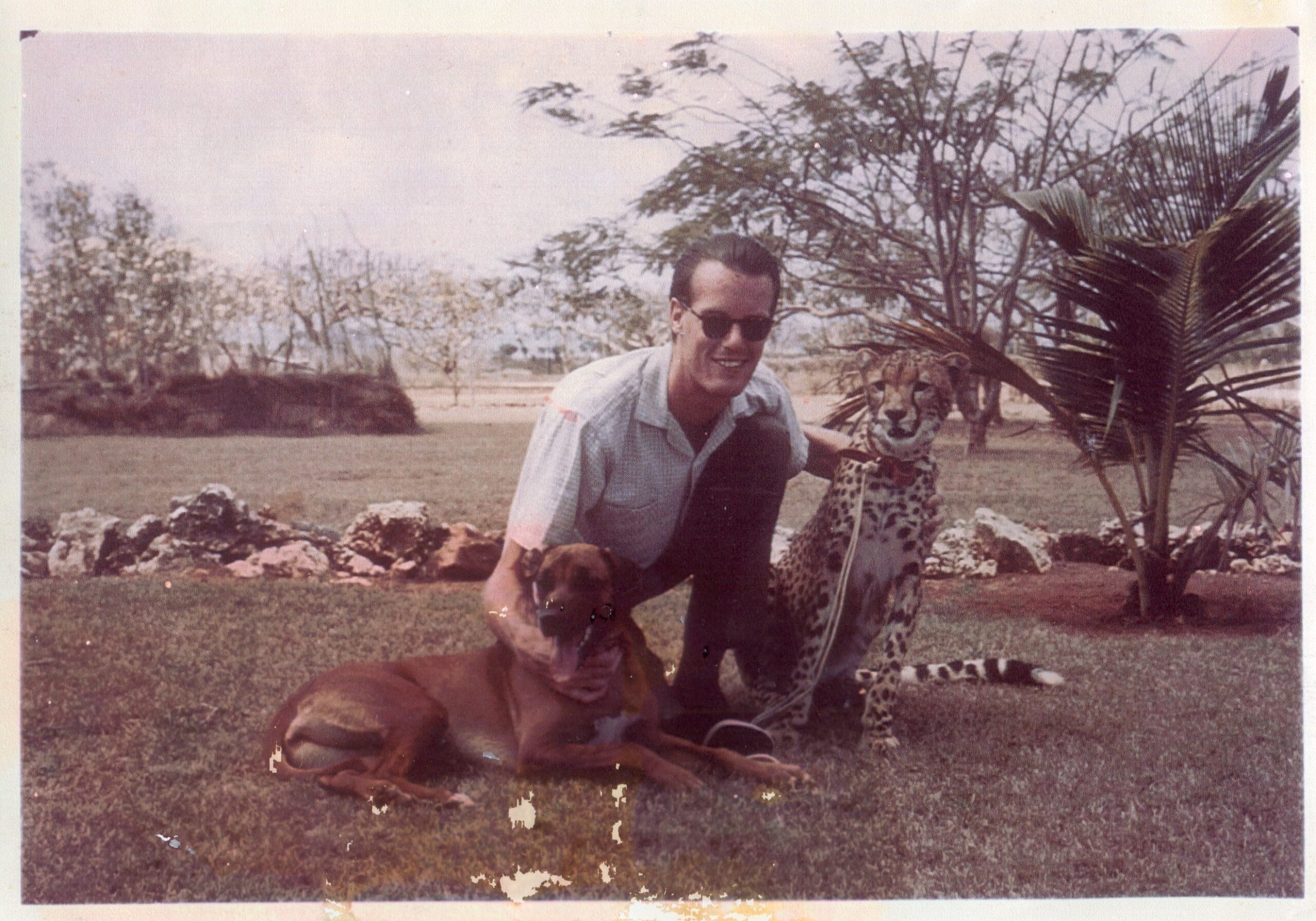
One of the problems ivory hunters had to deal with is the elephant that is shot so late in the day that you cannot chop the tusks out before dark. You can’t do it in the dark as you would risk cutting into a tusk so you have to wait for daylight. The problem there is that hyenas will come at night to feed on the carcass and they have been known to bite the ivory and their powerful jaws can do a lot of damage to the valuable ivory. You have to stand watch and fire a couple of shots in the air every few hours to keep them away and those big elephant rifle cartridges have never been cheap. This was not Giles’ favorite way to spend the night and he got to do it a lot more than he wanted to.
There were other dangerous game animals to be culled as well. An American mission could not bathe in their local lake because of three mean hippos that would drive out anyone trespassing on their lake. While hippos may look comical these bad tempered beasts kill more natives than any other animal in Africa. They are not to be messed with. Giles took a .375 H&H Magnum bolt action and shot the three of them thus providing a feast of hippo meat for all the children at the mission while making the lake safe for them. It should be noted that hippo meat is considered a delicacy.
Africa never changes and returning from a trip to Portuguese Angola, Giles got a good reminder of that. He was riding in a truck with his dog and his tracker was driving when they passed a native village. Giles was hungry and bade him stop to see if they had any food. The response was “Sure! Come join us!” Giles and his dog ate but his driver would not and the dog promptly threw up afterwards. Once back in the truck his driver said “You should not have eaten that.” “Why? What was it?” Giles inquired. “Mkono!” That’s Swahili for ARM! Giles was horrified and sure he had just contracted every venereal disease found in Africa. Fortunately, the meat was well done and he remained disease free. Hoping the driver was wrong Giles asked the district commissioner about the incident. The response was typically old Africa. “Sure he’s right. We lose more natives to cannibals in this district than we do to wild animals.” That was not what Giles wanted to hear but that was Africa.
There was another encounter with the natives that I will let Giles tell in his own words.
“In 1961 I was working in Karamojo, in the North of Uganda, and I was standing outside a tiny duka, or village shop, in the North of that area. I looked around on hearing a cough behind me and there was a Karamojong warrior standing a few feet away, who was one of the most unusual people I have ever seen; well over six feet tall, jet black skin, thin as a lath, and stark naked: the country was very dry and hot, and this is both traditional and sensible in the area. In his left hand he had his msamlio, which is a wooden mini-stool with three legs at right angles and is used as a pillow, and in his right hand he had his mkuki, or leaf bladed spear. This was lion country and he had a long walk home, so he needed the spear. He looked at the twentieth century with obvious contempt, which from his point of view was entirely understandable, and to me he was truly impressive.
“With him was his six-year-old son, who was a bit overwhelmed by the people and cars, which were obviously new to him, and he wanted to hold Daddy’s hand for reassurance, but Daddy didn’t have a hand spare. The boy reached up and found something to hold onto (!) and I could not resist taking a picture; those were the days of cassettes which you sent to a laboratory for processing, so I sent mine off and to cut a long story short, I never saw it again. This lab was in Durban and was notorious for stealing good films, which could be sold for good money to wildlife magazines.”
Elephants weren’t the only dangerous game stalked by Giles. He was friends with the famous snake expert Ionides and accompanied him on snake hunts. The gaboon viper is unique among venomous snakes in that it’s venom is both hemotoxic and neurotoxic, meaning it attacks both the blood and the nerves. It is a short, fat ugly snake and greatly feared. Ionides was an old man but he was so quick he would reach down and catch the gaboon viper right behind the head. I don’t believe I have heard of any other herpetologist gathering venomous snakes in this fashion and I doubt I ever will. Certainly not with any snake as deadly as a gaboon viper.
Africa’s antelope are not appreciated as dangerous game by most American hunters yet their horns can be quite lethal. In the antelope world the big five are eland, kudu, sable, roan, and Oryx. Of these the eland is the biggest and best tasting. He is also the best jumper which explains why this big antelope has not been made a farm animal. Like the kudu, he is shy and will run from a fight. The sable, roan, and Oryx are the tough guys. When Giles was hunting in Masailand an Oryx was attacked by wild dogs and impaled one of his attackers on his horns where the carcass was firmly stuck. For a long time that Oryx ran around with that wild dog’s skeleton on his head. Even more aggressive is the roan antelope while a wounded sable has accounted for many an inexperienced hunter who approached a downed sable too fast without putting an insurance shot in and was taken with one great sideways sweep of the deadly horns of the downed sable.
Giles shot both his roan and his sable antelope with the .500 Wilkes which eliminated tracking and wounded game problems in a most emphatic 570 grain manner putting the antelope down with authority.
Using the big double for everything was fairly common. A famous old hunter put it into words thusly “Use your big gun for everything Laddie and count it practice for the day your life depends on it!” The best advice ever given to a dangerous game hunter.
Blaney Percivel always shot everything with a .600 double. “Game shot with a .600 doesn’t travel far” he would explain. The better a tracker is at tracking the more frustrating it is when game escapes in conditions no tracker can follow successfully and the more he will try to avoid the chance of that recurring. That reason alone has been sufficient for many men to stick with the heaviest caliber gun they have.
The Kudu was taken with a borrowed Vickers .404 bolt action. A friend had been bragging about it so much that Giles wanted to try it out. Giles is right handed but has a left master eye so he shoots from the left shoulder. As a result, he is much better served by a double than a bolt-action. At 4:00 a.m. Giles’ tracker waked him asking “Did you want a choroa? (Oryx) Giles got out of the tent and saw the Oryx 170 yards away. Still in his pajamas, Giles took the .404 iron sighted Vickers and made a one shot kill from his tent. He then retired to the tent to get dressed and get his high topped boots on. Africa is no place for running around barefoot. It has too many venomous snakes, poisonous plant spines, and discarded porcupine quills.
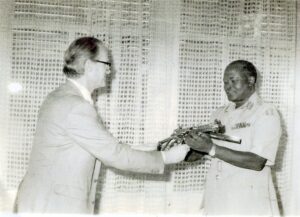
When he finally left Africa and returned to England, Giles became the head of Sterling Armaments, famed for making the Sterling submachinegun used by the British Army. In 1984 he made a return trip to Africa going to Kenya which had just ordered 500 Sterling submachineguns. Giles was taking a gold plated Sterling submachinegun as a present for the head of their army, General Mulinge, who Giles remembers as a very good fellow. The general had a colonel meet Giles at the airport and when a customs agent demanded Giles open his bag the colonel kicked him out of the way. Whatever was in that bag was nobody’s business but the General’s and Giles as far as the colonel was concerned. He was right. It had the gold plated presentation submachinegun in it.
After Sterling Armaments Giles entered the Best Quality gun trade taking care only to contract the cream of the workmen at the bench that actually make the guns that end up being sold under the famous expensive old names. He concentrates on the most expensive high end guns in the Best Quality field. In the 1990’s he completed the Paragon, the most elaborate Best Quality 12 bore side by side double of the 20th Century. This nitro proofed Damascus barrel masterpiece has every feature possible to add and is gold inlaid as elaborately as good taste will allow.
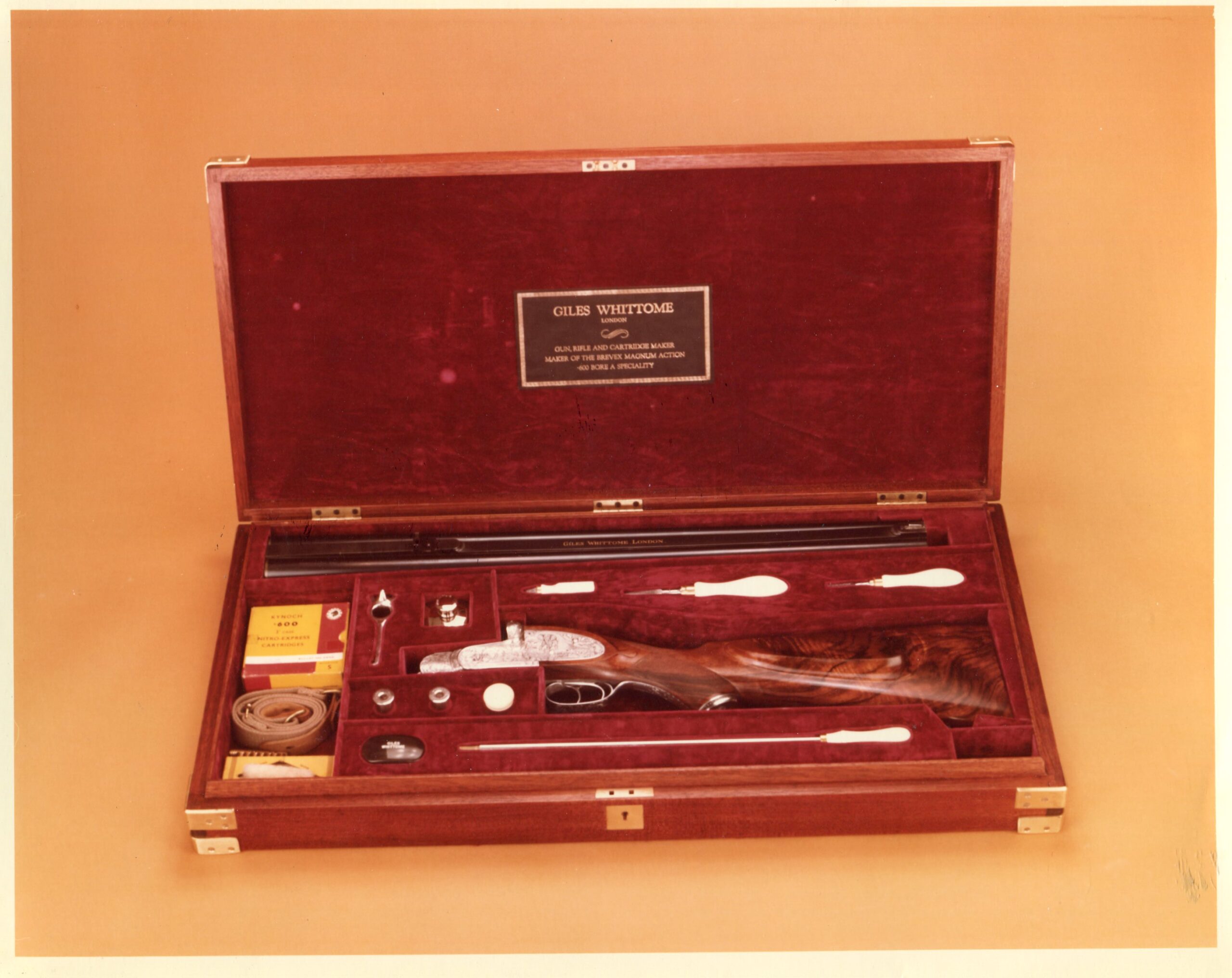
In the 21st Century he began making single shot .700 and 4-bore Best Quality falling block rifles culminating in his colossal 2-bore rifles. A small but steady and continuous stream of these has come from him ever since. This is the most powerful sporting rifle possible. The maximum load for the gun would kill the shooter so the loads are adjusted to the customer’s limits. For the man who wants the ultimate in stopping power this is unquestionably it. Giles will make any sort of Best quality gun ordered including 3-barrel side by side by side guns but the orders for the 2-bore rifles keep coming.
These monsters are also very accurate. To fire tight groups with a cannon like this Giles got a giant Scotsman that has been described as a cross between a grizzly bear and a Sherman tank, and who appears to be impervious to recoil as he completely disregards the hundreds of foot pounds of free recoil the 2-bore generates and he has fired a 50-yard group that was just one ragged hole.
Personally I just wish I could afford to have him make me a new .577 three-inch Nitro Express double rifle along the lines of the .600 double he made. One things for sure. When you order a dangerous game gun from Giles Whittome you are dealing with the gunmaker with the most personal experience in shooting dangerous game of any gunmaker in the British Best Quality gun trade today. He knows what’s needed first hand.

